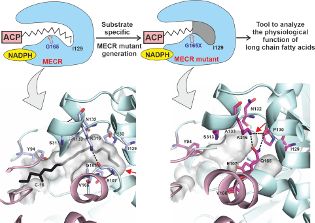Researchers confirmed the role of long-chain fatty acids in cellular respiration
2023-06-02

Cellular respiration is a complex and highly regulated process that allows cells to draw energy from nutrition. An international team of scientists from Finland, Germany and Poland have investigated the important role of long-chain fatty acids in guiding this process. The findings, published in Nature Communications, will shed light on the understanding of mitochondrial function that involve disruptions in cellular energy metabolism.
They are tiny and highly efficient energy factories operating inside our cells. Often referred to as "powerhouses," mitochondria extract most cellular energy from nutrition. Researchers from the University of Oulu, (Finland), the Heidelberg Institute for Theoretical Studies (HITS, Germany), and the Faculty of Physics of the University of Warsaw (Poland) have now succeeded in demonstrating that long-chain fatty acids produced by mitochondria are essential for the process called cellular respiration. The discovery is ground-breaking as the importance of long-chain fatty acids in this process had not been previously known, and the results open up a completely novel approach. "This information helps us understand diseases that involve impaired mitochondrial function and cellular respiration much better than before," says M. Tanvir Rahman from the University of Oulu and lead author on the paper.
The study is part of a more extensive research project investigating the connection between cellular respiration and the cell's nutritional state. The scientists used a protein engineering method, in which the mutants of the so-called MECR enzyme involved in mitochondrial fatty acid synthesis were designed using computational molecular modeling, along with structure determination by crystallography, and other experiments to validate the predictions. "Our study is an example of a successful case of targeted protein modification," says researcher Kaija Autio from the University of Oulu.
The experiments in this interdisciplinary study were carried out by biochemists and crystallographers from the Faculty of Biochemistry and Molecular Medicine of the University of Oulu and Biocenter Oulu, while the molecular modeling was done by computational biophysicists from the Heidelberg Institute for Theoretical Studies (HITS) and the University of Warsaw. "This study really demonstrates the value of combining computational and experimental approaches to reveal complex biomolecular mechanisms," says Rebecca Wade from HITS.
The study has received funding from the Academy of Finland, the Sigrid Jusélius Foundation, the Jane and Aatos Erkko Foundation, the Mary and Georg C. Ehrnrooth Foundation, Finnish Cultural Foundation, the Klaus Tschira Foundation, the Polish National Science Centre, and the BIOMS Center for Modelling and Simulation in the Biosciences at Heidelberg University.
Faculty of Physics at the University of Warsaw:
Physics and astronomy at the University of Warsaw appeared in 1816 as part of the then Faculty of Philosophy. In 1825, the Astronomical Observatory was established. Currently, the Faculty of Physics at the University of Warsaw consists of the following institutes: Experimental Physics, Theoretical Physics, Geophysics, the Department of Mathematical Methods in Physics and the Astronomical Observatory. The research covers almost all areas of modern physics, on scales from quantum to cosmological. The Faculty's research and teaching staff consists of over 250 academic teachers. About 1100 students and over 170 doctoral students study at the Faculty of Physics at the University of Warsaw. The University of Warsaw ranks in Shanghai Global Ranking of Academic Subjects among the world's top 75 units educating in physics.
SCIENTIFIC PUBLICATION:
T. Rahman, M., K. Koski, M., Panecka-Hofman, J. et al. An engineered variant of MECR reductase reveals indispensability of long-chain acyl-ACPs for mitochondrial respiration, Nat Commun 14, 619 (2023).
https://doi.org/10.1038/s41467-023-36358-7
SCIENTIFIC CONTACT:
Kaija Autio, Docent
University of Oulu
phone +358 294 48 1142
kaija.autio@oulu.fi
M. Tanvir Rahman, PhD
University of Oulu
mohammad.rahman@oulu.fi
Prof. Dr. Rebecca Wade
Molecular and Cellular Modeling group
Heidelberg Institute for Theoretical Studies (HITS)
phone +49 6221 533 245
rebecca.wade@h-its.org
Dr. Joanna Panecka-Hofman
Faculty of Physics, University of Warsaw
phone: +48 22 55 32 281
jpanecka@fuw.edu.pl
MEDIA CONTACT:
Agnieszka Fiedorowicz
Faculty of Physics, University of Warsaw
phone: +48 22 55 32 518
agnieszka.fiedorowicz@fuw.edu.pl
RELATED WEBSITES WWW:
https://www.fuw.edu.pl/faculty-of-physics-home.html
Website of the Faculty of Physics University of Warsaw
https://www.fuw.edu.pl/press-releases.html
Press service of the Faculty of Physics at the University of Warsaw
GRAPHIC MATERIALS:
FUW230602b_fot01
https://www.fuw.edu.pl/tl_files/press/images/2023/FUW230602b_fot01.jpg
Engineered protein mutation allowed to partially block the MECR enzyme's fatty acid-binding cavity, enabling analysis of mitochondria-produced long-chain fatty acid function.





